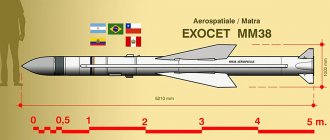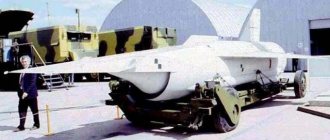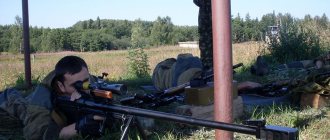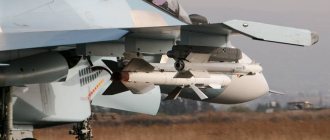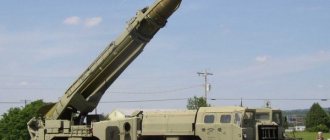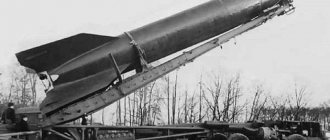Long-range aviation missile R-37 (RVV-BD)
The long-range guided missile R-37 (K-37, RVV-BD) is designed to destroy air targets (fighters, attack aircraft, bombers, military transport aircraft, helicopters, cruise missiles) at any time of the day, at all angles, in conditions of electronic countermeasures, against the background of the earth and water surface, incl. with multi-channel fire according to the fire-and-forget principle.
The development of the K-37 missile (product 610) to arm the MiG-31M interceptor based on the K-33 missile was started by the State Design Bureau "Vympel" according to the Resolution of the USSR Council of Ministers of April 8, 1983. The preliminary design of the missile was defended in 1983. The first flight of the MiG prototype -31M (serial number 05-01-01) took place on December 21, 1985. Tests of the K-37 began in 1988 with autonomous ballistic missile launches without a control system (10 launches). In 1989, the tests involved software missiles without a guidance system (4 launches) - flying under the control of an autopilot according to the program.
Also in 1989, tests of missiles with a guidance system began (2 launches). In April 1994, an aerial target was successfully hit at a record range of 304 km. The missile tests continued until 1997. After 1997, due to a violation of cooperation with Ukrainian enterprises that were involved in the creation of missile guidance systems, a decision was made to develop a guidance system using only Russian components. The MiG-31M with the K-37 missile was presented at the international aerospace salon MAKS-1997 (see.
,
,
,
,
,
,
,
), was not accepted into service with the Russian Air Force.
The resulting groundwork was used to create an aviation interceptor complex for the MiG-31BM fighter-interceptor. The modified missile, made from Russian components, received the designation K-37M (product 610M). Under the designation RVV-BD (product 620), the missile was repeatedly exhibited at military equipment exhibitions.
The most important improvement compared to the previous version is the use of the new MFBU-610MSh control system for the K-37M. K-37M guided missiles (item 610M) were first launched from the MiG-31 in 2011 and completed state tests in 2014. Currently, the rocket is produced by the KTRV corporation in Korolev, the production of the on-board control complex is entrusted to the Ural design bureau "Detal".
The MiG-31BM are equipped with a new weapons control system and radar. The upgraded weapon control system RP-31MA "Zaslon-AM" (S-800AM) with an 8BM radar received a new computer "Baget-55-06" instead of "Argon-15A". The passive antenna with electronic beam steering remains unchanged. The detection range of the modernized radar station is 320 km, automatic tracking is 280 km (fighter detection range is 240 km). 24 targets are simultaneously tracked, of which 6 are simultaneously fired at by missiles (in the previous version - 10 and 4, respectively). The 8TK thermal direction finder remained unchanged.
In the front cockpit, some mechanical instruments have been replaced with a 127x127 mm LCD display located on the right side of the instrument panel. The operator's cabin (rear) received two large 152x203 mm LCD displays instead of cathode ray tubes. The aircraft received new communications equipment (radio R800L) and improved radio navigation equipment, including the A737 satellite navigation system. The large weapons pylons (previously intended for R-40TD missiles) disappeared from the wing, which were replaced with suspensions sufficient for R-77-1 or R-73 missiles. In addition, external hardpoints, previously used only for mounting additional fuel tanks, can now accommodate air-to-air missiles. The MiG-31BM is slightly heavier than the “B” version - the maximum take-off weight is 46,835 kg, and the flight data has remained virtually unchanged, with the exception of the ceiling, which has dropped to just over 20,000 m.
Serial production of the RVV-BD missile began in 2014. In the west, the missile was designated AA-X-13 Arrow.
Model of a long-range air-to-air guided missile R-37M on an AKU-620 aircraft ejection device under the wing of a Su-35S fighter (tail number “51 red”) on display at the MAKS-2019 air show. Zhukovsky, August 2022 (c) Mikhail Zherdev
Bomber killer: why the Russian R-37M missile is feared in the West
Retired US Air Force Colonel Mark Gunzinger, director of the Future Concepts and Military Capability Assessment program at the Mitchell Institute for Aerospace Studies, said Russian R-37M missiles pose a serious threat to US bombers and early warning aircraft. According to the analyst, the danger to the US Air Force comes not only from modern Russian integrated air defense systems, but also from fighters equipped with active phased antenna radars, infrared sensors and long- and ultra-long-range air-to-air missiles.
Russian R-37M missiles can easily destroy expensive American airborne assets, such as airborne early warning and control aircraft, air tankers and bombers that are not made using stealth technology, noted Mark Gunzinger.
At the same time, the American colonel called the Su-57, Su-37 and MiG-35 fighters that are part of an integrated air defense system and are capable of “destroying” US aircraft.
twitter.com / @mod_russia
Popov , deputy editor-in-chief of the Aviapanorama magazine, Major General, Honored Military Pilot of the Russian Federation, Candidate of Technical Sciences , said in an interview with iReactor, the fears of the American analyst are more than justified. Currently, the entire range of weapons installed on Russian fighters is sufficient to counter absolutely any enemy in the air, the expert is convinced.
Modern weapons that are developed and modified in Russia are, in fact, extremely dangerous for any enemy air targets, ranging from unmanned aerial vehicles and heavy drones, to large aircraft such as strategic bombers, missile carriers, and early warning aircraft. By the way, the US Air Force has a lot of the latter,” said Vladimir Popov.
He also added that the R-37M missile provides great capabilities to the fighter formations of the Russian Air Force. Thus, thanks to this weapon, it becomes possible to effectively intercept fighters, attack aircraft, and electronic warfare aircraft at long ranges. In addition, in long-range air combat, aircraft armed with the P-37M will also have an advantage.
wikimedia.org/Dmitriy Pichugin/GFDL 1.2
Currently, in addition to Russia, the PRC is the owner of ultra-long-range air-to-air missiles. At the same time, the United States, which has traditionally been a leader in the creation of aircraft ammunition, has found itself among the main outsiders in this area. The reason for this is the peculiarities of the strategy for developing its own air force. In 2017, Lockheed Martin began development of its advanced long-range air-to-air missile AIM-260 JATM. However, the Pentagon has still not reported on the successful testing of its prototypes.
The vulnerability of American aviation lies in the peculiarities of its strategy. The F-35 and F-22 fighters are stealth aircraft that must manage to complete a combat mission outside the field of view of foreign aircraft. That is, they must strike enemy aircraft first and escape unnoticed. The range of radar detection stations on aircraft is within 90-100 km. Today this strategy is obviously losing. Even fourth-generation Russian aircraft can detect and auto-escort American fighters,” noted iReactor’s interlocutor.
According to information presented in a number of world media, the maximum launch range of the R-37M missile is estimated at 200 km. However, these values are typical for the export version of the weapon, while the range of the models designed for the Russian Air Force is estimated at more than 300 km. In addition, the R-37M homing head ensures target acquisition with a large reflective surface. This is achieved due to the fairly large diameter of the rocket and, as a consequence, the homing head antenna.
Let us recall that earlier analysts from the authoritative Vietnamese publication Soha reported that the deadly Russian Su-57 stealth fighters would cause a lot of problems for the United States in the event of an armed conflict between the countries. As Eastern experts emphasized, the Russian aircraft is equipped with the most modern avionics equipment, and is also suitable for using a wide range of weapons systems, including the R-77M, R-74M2 and R-37M.
Design[edit]
The R-37 was developed from the R-33. For compatibility with aircraft that did not have the sophisticated radar of the MiG-31, the semi-active seeker was replaced by the Agat 9B-1388 version of the active seeker. [2] Similarly, the folding tail allows semi-conformal transport [2] on aircraft that are not as large as the MiG-31.
Straightening the midsection increases lift [2] and therefore increases flight range. According to Defense Today, the range depends on the flight profile, ranging from 80 nautical miles (150 km) for a straight shot [2] to 215 nautical miles (398 km) for a cruise glide profile. [2] According to Jane, there are two variants: the R-37 and the R-37M; the latter has a jettisonable rocket booster increasing the range to "300–400 km" (160–220 nm). [3]
R-37M
the designation has since been used for an upgraded version of the missile, also known as RVV-BD (Rocket-Vozduh VOZDUH Bolyshoy Dalnosty, or long-range air-to-missile).
The flight range of the R-37M exceeds 300 km, and at the final stage of flight it is capable of reaching hypersonic speed (~ Mach 6). [6] It will be carried by modernized MiG-31BM fighter-interceptors and Su-35S and Su-57 multirole fighters. [7] It is unknown whether the long-range air-to-air missile for the Su-57, designated Izdeliye 810
, is a derivative of the R-37M.
[ citation needed
]
The missile is capable of hitting targets at an altitude of 15–25,000 meters with semi-active or active guidance using the Agat 9B-1388 system. [8]
Fatal hypersound! Will the R-37M ensure dominance over NATO aviation without a direct-flow partner?
A lot of discussion on the Russian Internet was caused by the news about the upcoming acquisition of operational combat readiness of the heavy ultra-long-range hypersonic air-to-air missile R-37M, which should become the “largest caliber” for gaining air supremacy in the ammunition of the 5th generation multifunctional fighters Su-57 . However, the arrival of an experimental military batch of these products to the combat units of the Aerospace Forces, equipped with the first production Su-57, announced by the General Director of Tactical Missile Armament Corporation JSC Boris Obnosov during a conversation with Interfax journalists, unfortunately, is difficult to classify as section of high-profile news in the field of formation of the Russian Aerospace Forces. And there are several extremely good reasons for this.
Firstly, taking into account the July statement of the chairman of the State Duma commission on legal support for the development of military-industrial complex organizations, Vladimir Gutenev, which was remembered far from in the best light, about the allegedly “unjustified high cost of serial production of the Su-57 and providing delicate services for these machines,” as well as information from the Deputy Minister defense Alexey Krivoruchko about the transfer in 2019 to the Lipetsk 4th Center for Combat Use and Retraining of Air Force Flight Personnel only 2 PAK FA, it is easy to assume that on the same European theater of operations, replete with hundreds of modern transitional generation fighters (F-16C/D Block 52+ , “Rafal” and “Typhoon”), a “bundle” of two “Sushka” and 8 R-37M in their internal weapons compartments will not make any special weather. The maximum that can be counted on from such a small unit in combat conditions is, for example, the destruction of one or a couple of E-3A/C radar patrol and guidance aircraft using R-37M missiles, as well as the interception of a couple of F-15E " Strike Eagle" and F-35A using medium-range air combat missiles.
Secondly, the R-37M URVB does not belong to the promising types of air-launched interceptor missiles, but is only an improved modification of the already known ultra-long-range air-to-air missile R-37 (RVV-BD), developed on the basis of the R-33 /C for integration into the weapons control complex of the MiG-31BM long-range interceptor, which provides for software and hardware synchronization of the “Product 610M” with the powerful onboard radar complex “Zaslon-AM”. As a result, the optional upgrade package for the R-37M, in comparison with the regular R-37, includes only a more advanced data exchange bus, allowing it to be used not only in the KUV and ammunition of the modernized Foxhound, but in the weapons kits of the stealthy Su-57 fighters, as well as the transitional generation “4++” Su-30SM and Su-35S. At the same time, the slightly modified brainchild of the state machine-building design bureau "Vympel", apparently, retained all the design features (and therefore the shortcomings) of the missiles of the R-33S/R-37 family, which will make it possible to effectively use it only for the elimination of airborne operations - strategic means of information support for the enemy (UAVs RQ-4A/B "Global Hawk", MQ-4C, RTR RC-135V/W aircraft, radar reconnaissance E-8C, etc.), as well as tactical fighters carrying suspension with a full combat load in the shock version and having mediocre maneuverability.
The fact is that, despite the maximum speed on the cruising section of the trajectory of 6M (6380 km/h), the design safety factor of the R-37M allows it to realize its own overload of only 20-22 units, which determines the maximum overload of the target to be hit at 7 -8 units Moreover, such an indicator can only be achieved if the R-37M’s approach speed is about 1,700 km/h or more. Conclusion: if a maneuvering enemy fighter flies in low-altitude or medium-altitude mode, then it will be extremely difficult to intercept it when launching from a distance of 250-300 km, since the R-37M moving along an aeroballistic trajectory will use up the solid fuel charge of the engine at the beginning of the marching section of the trajectory , which means that when returning to the dense layers of the stratosphere and troposphere, the interceptor missile will lose speed at a galloping pace due to aerodynamic braking, which will ultimately reduce its maneuverability to zero. Of course, the partial preservation of the rocket’s speed parameters in the dense layers of the atmosphere is facilitated by a mass of 600 kg, but the body diameter of 380 mm, providing a high aerodynamic drag coefficient, is still the determining characteristic in the deterioration of the energy parameters of the R-37M at distances close to the maximum range of action.
As for the missile’s avionics, in particular the active radar seeker, then, at first glance, everything is going quite well. Active radar homing head 9B-1103M-350 “Puck” with an antenna surface diameter of 350 mm (installed on a standard R-37) allows you to lock on a target with an EPR of 1.5 square meters. m (F/A-18E/F “Super Hornet” with suspension) at a distance of 30 km, while the frequency of a higher-performance on-board computer reaches 50 MHz, and conventional mechanical gyroscopes are replaced by fiber-optic and mechanical ones with forced launch.
The developer states that the range of the radio correction channel from the carrier for a standard R-37 reaches only 100 km (1/3 of the range). This means that, starting from a distance of 100 km, the R-37 (and possibly the R-37M) switches to semi-active radar homing, which can be disrupted by modern electronic warfare stations such as AN/ALQ-249 “Next Generation Jammer”, which will soon be equipped with US carrier-based electronic warfare aircraft EA-18G “Growler”. Consequently, the R-37/M will switch to inertial guidance mode with all the ensuing consequences, one of which is the error in reaching a target that does not stand still. And if, at the moment of approaching the target at a distance of 30-40 km, the scanning cone of the Shayba seeker covers the latter (this may not happen), then a “re-capture” will occur, allowing the interception to continue. But this will require a sharp maneuver by the R-37M, which will deprive the missile of another 15-20% of its speed. There will be nothing to compensate for this loss, since the charge of the solid propellant rocket motor is used up. Here are the main disadvantages of the AA-13 “ARROW”. There is no point in exaggerating the problem of the large EPR of the R-37M, which makes it vulnerable to the ship-based SM-6 (RIM-174 ERAM) missiles and AIM-120C-7/D air combat missiles; This has been known to specialists for a long time. It’s time to recall another long-range air combat missile, which was forgotten by both the Ministry of Defense and the Russian Aerospace Forces.
We are talking about the unique “Product 180-PD” (air-to-air missile RVV-AE-PD), equipped with an integral ramjet rocket engine, which allows maintaining the highest maneuverability and speed even at critical distances close to the operational range. This product, development and research work on which was completed back in 2012, could not only complement the far from brilliant capabilities of the R-37M in the fight against enemy tactical aircraft, but also fend off the threat from similar British MBDA Meteor missiles ", which have long been ahead of our serial RVV-SD and R-27ER. The ability to regulate the supply of a gas generator to the IRPD by means of a special valve in front of the combustion chamber would make it possible to maintain flight at a moderate speed of 2.7-3M for more than 140-150 km from the release point from the suspension unit, after which the full fuel supply was opened, and the rocket accelerated to 4.3-4.7 M, which would ensure the interception of even maneuvering anti-ship missiles at a range of 170 km. However, neither the Vympelov team (given the lack of funding) nor the Ministry of Defense are still in any hurry to implement this wonderful project, and this is alarming...
Sources of information: https://nevskii-bastion.ru/rvv-ae-pd/ https://militaryrussia.ru/blog/topic-106.html https://rbase.new-factoria.ru/missile/wobb/ meteor/meteor.shtml https://www.interfax.ru/russia/630714
Links[edit]
- https://www.ausairpower.net/SP/DT-Missile-Survey-May-05.pdf
- ^ abcdefgh "Missiles in the Asia-Pacific" (PDF), Defense Today
: 67, May 2005, archived from the original (PDF) on January 26, 2009. - ^ abcdefg "R-37, R-37M (AA-X-13) (Russian Federation), AIR-TO-AIR MISSILES - BEYOND VISUAL RANGE". janes.com
. January 12, 2009 Archived from the original on September 14, 2008. - "New integration of Russian long-range surface-to-air missile systems to expand to four fighter models - Jane's 360". janes.com
. July 9, 2022. Archived from the original on July 13, 2022. Retrieved January 4, 2022. - https://www.vpk-news.ru/articles/52503
- "Military tests long-range missile for Su-57". N+1
. - https://www.thedrive.com/the-war-zone/36899/russian-air-to-air-missile-tests-signal-potential-new-capabilities-for-flanker-and-felon
- “RVV-BD long-range air-to-air guided aircraft missile.” missile.ru
. October 2011. Retrieved August 26, 2022.
Russian Aviation
Tests of the long-range air-to-air missile R-37M (RVV-BD) are being completed. This is the longest-range guided missile in service with the leading world powers - it is capable of hitting high-speed, high-altitude (25 km) and low-flying (15 m) air targets at a distance of up to 300 km.
According to information from the Izvestia newspaper received from the Ministry of Defense, the product is in a high degree of technical readiness.
Target targeting accuracy is ensured by the fighter's radar system, as well as an inertial control system and an active radar seeker with a built-in miniature processor with a large amount of memory and increased speed. Fiber-optic and mechanical gyroscopes with forced entry into operating mode ensure minimal preparation time for the rocket for launch.
The R-37M is a further development of the previous generation R-37 long-range missile, whose development began in the USSR in the 1980s. The missile entered service in 1989 and was intended for use on MiG-31 interceptor fighters.
Ukrainian enterprises were involved in the creation of missile guidance systems; due to a breakdown in cooperation ties in the late 90s, a decision was made to develop a seeker using only Russian components. But such work actually began only in the late 2000s.
In order for the R-37M to be used not only on the MiG-31, but also on the Su-30SM and Su-35, as well as on the PAK FA - Su-57, the length of the rocket was reduced by 14 cm and its launch weight was reduced.
The R-37M can destroy air targets on a collision course. After pointing the missile at the target and launching it, an inertial control system operates during the sustaining phase of the flight. In this case, the enemy does not see the approaching missile. Before the target, during the final part of the flight, the missile accelerates to a hypersonic speed of 6M and the active seeker is turned on. At this moment, it becomes visible on the monitor of the enemy aircraft, but the pilot has only a split second to make a decision and perform an evasive maneuver.
The direct competitor of the Russian R-37M missile is the American AIM-120 AMRAAM. The missile is equipped with F-22 and F-35 fighters. However, the maximum launch range of this missile is 180 km.
Previously, the US Navy was armed with the AIM-54 Phoenix long-range missile with the ability to hit targets at a distance of up to 200 km. The only carrier of this missile was a two-seat fighter with variable wing geometry - the F-14 Tomcat. After 2006, when these aircraft were withdrawn from the Navy, the AIM-54 was withdrawn from service and is now only available in the Iranian Air Force.
In the photo: launch of the main engine of the K-37M rocket / drawing by Alexander Yartsev, 2014, https://www.deviantart.com/abiator/art/R-37-AA-13-Arrow-engine-start-500205646
- 07/07/2018 Why the Su-35 will not be the last version of Russia’s most successful fighter
- 12/27/2015 Modernized MiG-31BM arrived in the Far East
- 06.28.2020 “Flock” of VKS fighters practiced elements of network-centric combat operations
- 02/16/2016 Composition of the Russian group in Syria: equipment and weapons
( 3 ratings, average: 5.00 out of 5)
R-37MSu-30SMSu-35Su-57
History[edit]
The rocket was designed in the early 1980s and first flew in 1989. [3] Testing of the P-37 continued throughout the 1990s, [3] and in 1994 a test round was killed at a range of 162 nautical miles (300 mi). km). [2] However, the program appears to have been discontinued around 1998 due to high costs. [3]
Work on the missile appears to have resumed in late 2006 [3] as part of the MiG-31BM program to upgrade the Foxhound with a new radar and ground attack capability. [3]
In 2022, the R-37M completed operational tests. [4] [5]
Production[edit]
The R-37 is currently being produced to equip the modernized Russian MiG-31BM interceptors.
New in blogs
The publication Strategic Culture assessed the new Russian hypersonic air-to-air missile Vympel R-37M. Today it is the longest-range rocket in the world.
R-37M missiles (according to other classifications Izdeliye 610-m or RVV-BD) will be equipped with fifth-generation fighters. Although it was originally planned to use it on MiG-31 interceptors. In July of this year, the Russian Ministry of Defense announced the final tests of the missile and its imminent entry into service with the army.
The R-37M is the only missile of this class that can cover a distance of over 300 km. If we compare it with the American AMRAAM AIM-120D, the advantage of the Russian missile is clearly visible. Range of US AMRAAM AIM-120D 180 km.
The R-37M is a continuation of Soviet developments (for example, the R37 Arrow - Strela, as it was called in NATO), which were also champions in range. But this modification also has a new guidance system and lighter weight, which allows it to be used even on small platforms. This hypersonic missile is expected to become the main weapon for the Su-30 and Su-35 aircraft. In this case, the missile will participate in almost all theaters of military operations.
The main task of the R-37M missile system is the destruction of enemy systems such as AWACS, JTARS and other C4-ISTARs, which are used for reconnaissance and surveillance. In addition, it is intended to conduct electronic attacks and destroy air targets. The warhead weighs 60 kg, which has enough explosive power to neutralize a large aircraft.
The missile's maximum speed is Mach 6 (AMRAAM reaches Mach 4), which is over 4,500 miles per hour, and it has an active seeker homing system, which is a serious threat to attack aircraft. The finder operates in two ranges - X and Ku.
Equipping combat aircraft with this missile gives an advantage over any NATO combat aircraft in speed and in hitting targets. Not a single missile of this class can compare with the R-37M. Once Russia begins operating this missile, the vulnerability of NATO aircraft will be exposed until NATO operationalizes the Meteor ICBM of a similar class. Currently, such missiles are being introduced into the Swedish Air Force.
The missile can hit targets at altitudes from 15 m to 25 thousand. But it can attack stealth aircraft, such as the F-35, at a range of 190 km. Since the F-35 does not develop such speed, it will not be able to get away from the R-37M.
The Vympel targets its targets using semi-active or active radar homing. The rocket can use the "attack-and-forget" mode, which makes it completely free from the launch pad. She also has access to a frontal attack. Inertial guidance makes it invisible to radars during flight (in the middle of flight).
If active homing is engaged against the P-37M, the pilot has a few seconds to implement countermeasures. The R-37M warhead is resistant to electronic warfare and is capable of close combat.
During exercises conducted in Transbaikalia in September of this year, an R-37M missile launched from a MiG-31 BM intercepted an Armavir RM-75 launch vehicle in the stratosphere. Armavir's speed is estimated at 2.5-50 thousand km/h. The R-37M hit the target within 5-7 seconds at an altitude of 9 km from a distance of 30 km.
The pride of the American military, the newest F-35 is not able to withstand such complex air-to-air systems produced by Russia. The R-37M is integrated with at least four platforms and is a significant threat to stealth. AWACS and larger non-stealthy aircraft are even more vulnerable.
Nowadays, the United States does not have weapons that can provide it with air superiority in the event that Russia is the enemy. The United States has lost its leadership in air-to-air combat because the P-37M is unmatched in performance. Russian missiles of this class are superior to all American counterparts.
Who is leading the development of ultra-long-range air-to-air missiles?
Leonid Nersisyan, April 20, 2022, 10:32 — REGNUM As it recently became known, the Russian Air Force is working to integrate long-range R-37M air-to-air missiles into the armament of Su-35S fighters. A source in the Russian military-industrial complex told Izvestia about this. As expected, test launches of this missile from Su-35S fighters are expected to take place at the end of 2022, after which mass equipping of them with the new missile will begin. Previously, the R-37M was put into service, and it is equipped with the MiG-31BM and MiG-31BSM fighter-interceptors, for which it was created. However, subsequently it was decided to adapt it for use as part of the armament of Su-35S fighters. As previously stated, the latest fifth-generation Su-57 fighters can also be carriers of the R-37M.
P-37 missile
Ivan Shilov © IA REGNUM
In addition, according to as yet unconfirmed information, in the future there may be talk of equipping Su-30SM fighters with the R-37M missile. Thus, in the coming years, most Russian fighters may be armed with new long-range missiles. Let's consider what this missile is and what is Russia's current position in the field of creating long-range aircraft missiles?
The history of the R-37 rocket began in the late 1980s. This product was created to replace the R-33 missile, which is the main caliber of the MiG-31 interceptor. Compared to the R-33, the new missile was supposed to have more than twice the flight range and an active homing head. In parallel with the R-37, another promising long-range air-to-air missile, the KS-172, was being developed, designed to equip air superiority fighters. However, the collapse of the Soviet Union and the events that followed led to the cessation of work on the creation of ultra-long-range aircraft missiles. In 1994, test launches of prototype R-37 missiles were carried out, during which it was possible to intercept a target at a record distance of 304 kilometers from the launch point.
KS-172 rocket
Piotr Butowski
Work on a new long-range missile was resumed only in the late 2000s. Compared to the original missile, the length of the R-37M was slightly reduced, and most importantly, the electronic part of the missile underwent dramatic changes and was made on a modern element base. In particular, the missile is equipped with a modern and much more advanced homing head 9B-1103M-350, which ensures guidance of the missile in its final phase. On the main part of the trajectory, the rocket is controlled by an inertial navigation system with radio correction from the carrier. Compared to the R-33, the ability to hit maneuverable targets has increased significantly.
In a number of domestic media, the maximum missile launch range is estimated at approximately 200 kilometers. However, it is worth noting that this range is stated for the export version of the missile, while the range of the R-37M designed for the Russian Air Force is estimated at no less than 300 kilometers. According to Western estimates, the missile’s launch range can range from 150 kilometers when flying along a straight trajectory and up to 400 kilometers when flying along an aeroballistic trajectory. Maximum range estimates are applicable only in the case of firing at large and weakly maneuvering targets on a collision course.
The homing head (GOS) of the missile ensures the acquisition of a target with a large reflective surface (five or more square meters) at a range of 40 kilometers. This capture range is achieved, among other things, thanks to the fairly large diameter of the missile, and as a consequence, the seeker antenna. However, the large diameter of the missile does not allow it to be placed in the internal weapons compartments. Thus, the newest Russian fifth-generation fighter will be able to use the R-37M only on external slings.
According to available data, serial production of the R-37M began in 2014, but how many of these missiles are in combat units remains unknown, especially considering that data on aircraft weapons in the Russian Air Force is extremely confidential. At the same time, R-37M periodically appeared in photographs of modernized MiG-31 interceptors, which allows us to speak with a high degree of confidence about the presence of a certain supply of new missiles. The new missile provides the Russian Air Force fighter formations with radically new capabilities. In particular, thanks to this missile, it becomes possible to effectively intercept attack aircraft before they launch cruise missiles and glide munitions, and defeat long-range radar detection aircraft and electronic warfare aircraft at long ranges. In long-range air combat, fighters armed with the R-37M will also have a significant advantage; the effective range of this missile will in any case be greater than that of medium-range missiles.
R-37 long-range air-to-air missile
Vitaly V. Kuzmin
In addition to Russia, China is the owner of ultra-long-range air-to-air missiles. It is known that China has a new long-range missile PL-15, which is equipped with a ramjet engine and is capable of reaching a maximum speed of five times the speed of sound. Estimates of the PL-15 range vary widely - from 150 to 300-400 kilometers. Probably, like the P-37M, the range of the PL-15 depends on the type of target hit and the trajectory.
At the same time, the United States, which has traditionally been a leader in the creation of various aircraft ammunition, is currently an outsider in the field of creating long-range missiles. Since 2017, the Lockheed Martin Corporation in the United States has been developing a promising long-range air-to-air missile, the AIM-260 JATM, which is being created as a response to the Russian R-37M and Chinese PL-15. According to the plans of the American military department, tests of the AIM-260 should begin in 2022, and full-scale purchases from the 2026 fiscal year.
Chinese Chengdu J-20 fighter with four PL-15s inside the weapons bay
Well, for now, Russia occupies a leading position in the development of ultra-long-range air-to-air missiles, and the new capabilities of the Russian Air Force for long-range air combat directly depend on the rate of production of new R-37M missiles and their quantity.




